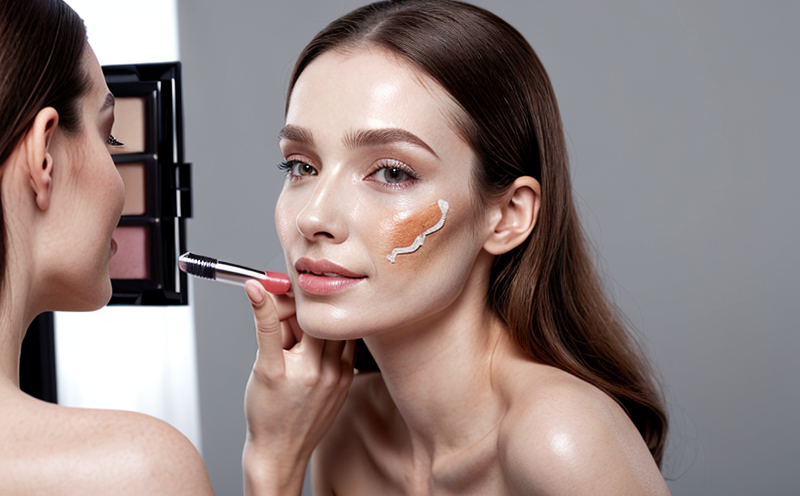Dermatological Safety of Acne Care Cosmetic Creams
The dermatological safety assessment of acne care cosmetic creams is a critical step in ensuring that these products are safe for use and effective in treating or preventing acne. This evaluation involves a series of tests aimed at identifying potential allergens, irritants, and sensitizers present within the product formulation. The primary goal is to ensure compliance with international standards such as ISO 20792:2016 and ASTM F801-14, which provide guidelines for assessing cosmetic products.
During this testing process, specimens are subjected to various analytical methods designed to detect impurities that may cause adverse skin reactions. These tests include in vitro methods using human cell lines or reconstructed human epidermis models, as well as in vivo studies involving patch testing on volunteers. The results from these evaluations help manufacturers understand the potential risks associated with their products and make necessary adjustments before commercial release.
For acne care cosmetic creams specifically, additional considerations are taken into account to ensure they do not exacerbate existing conditions or induce new ones. This includes examining the pH level of the cream, its comedogenicity rating (a measure of how likely it is to clog pores), and whether any ingredients might trigger inflammatory responses in individuals with sensitive skin.
The importance of this type of testing cannot be overstated given that millions of people worldwide suffer from acne. By rigorously evaluating new formulations through dermatological safety assessments, companies can contribute positively towards improving public health by providing safe and effective treatments.
Why Choose This Test
Choosing to undergo a dermatological safety assessment for acne care cosmetic creams offers numerous advantages that benefit both manufacturers and consumers alike. For one, it ensures compliance with regulatory requirements set forth by organizations like the FDA (United States), EMA (European Medicines Agency), and other national authorities worldwide. This helps protect your brand's reputation while avoiding costly legal issues down the line.
Additionally, successful completion of these tests can enhance consumer trust in your products by demonstrating a commitment to quality and safety. Many consumers are increasingly concerned about what goes into their skincare routine; showing that you've taken steps to ensure it won't harm them is essential for building long-term loyalty among customers.
Achieving certification through recognized standards also opens up market opportunities both domestically and internationally, making your products more attractive to retailers and distributors. It signals to potential partners that you prioritize safety above all else – an increasingly important factor in today's competitive marketplace.
International Acceptance and Recognition
The dermatological safety assessment of acne care cosmetic creams is widely recognized across various regions due to its alignment with international standards such as ISO 20792:2016, ASTM F801-14, and EN 1532. These guidelines provide a consistent framework for evaluating the safety of cosmetic products globally.
Many countries have adopted these standards into their local regulations, ensuring that manufacturers adhering to them meet acceptable levels of safety. For example, in Europe, the Cosmetics Regulation (EC) No 1223/2009 requires all cosmetics sold within EU member states to comply with these standards.
In North America, while there isn't a single regulatory body overseeing all cosmetic products at the federal level, individual states often reference international standards in their own legislation. Similarly, Asia-Pacific countries like Japan and South Korea have incorporated similar criteria into their respective cosmetic laws.
The widespread adoption of these standards reflects an industry-wide consensus on what constitutes safe cosmetics. By choosing to undergo this type of testing, you're positioning yourself as a leader in the field who takes responsibility for product safety seriously.
Use Cases and Application Examples
| Use Case/Application Example | Description |
|---|---|
| Evaluation of New Acne Care Formulations | Testing new ingredients or reformulating existing products to enhance efficacy while maintaining safety. |
| Detection of Allergens and Irritants | Identifying potential allergens like parabens, fragrances, and preservatives that could cause adverse reactions. |
| Comedogenicity Testing | Evaluating the likelihood that a product will clog pores, which is crucial for acne-prone individuals. |
| Skin Irritation Assessments | Using in vivo and in vitro methods to determine whether the cream causes irritation or sensitization on human skin. |
| Patch Testing Studies | Conducting patch tests on volunteers to observe any signs of allergic reactions after using the product for extended periods. |
| Microbial Contamination Analysis | Checking for contamination levels that could lead to infections or other health hazards. |
| Skin Sensitization Testing | Determining if the cream contains ingredients capable of triggering sensitization responses in individuals with sensitive skin. |
The above table provides a comprehensive overview of some common use cases and application examples for dermatological safety assessments related to acne care cosmetic creams. Each scenario highlights different aspects of product development, quality control, and consumer protection that are essential considerations when bringing a new formulation to market.





